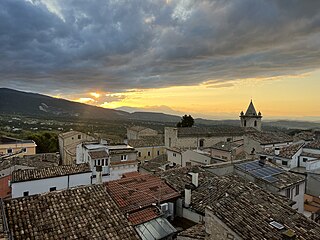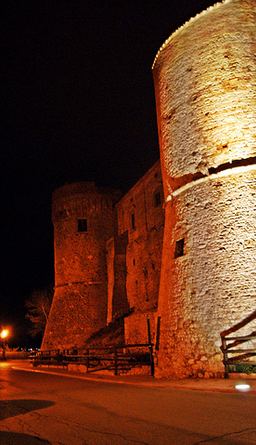
Abruzzo, historically known as Abruzzi, is a region of Southern Italy with an area of 10,763 square km and a population of 1.3 million. It is divided into four provinces: L'Aquila, Teramo, Pescara, and Chieti. Its western border lies 80 km (50 mi) east of Rome. Abruzzo borders the region of Marche to the north, Lazio to the west and north-west, Molise to the south and the Adriatic Sea to the east. Geographically, Abruzzo is divided into a mountainous area in the west, which includes the highest massifs of the Apennines, such as the Gran Sasso d'Italia and the Maiella, and a coastal area in the east with beaches on the Adriatic Sea.

The province of Chieti is a province in the Abruzzo region of Italy. Its provincial capital is the city Chieti, which has a population of 50,770 inhabitants. The province has a total population of 387,649 inhabitants as of 2017 and spans an area of 2,599.58 square kilometres (1,003.70 sq mi). It is divided into 104 comuni (comune) and the provincial president is Mario Pupillo.

The province of Pescara is a province in the Abruzzo region of Italy. Its provincial capital is the city Pescara, which has a population of 119,483 inhabitants. As of 2017, it has a total population of 319,936 inhabitants over an area of 1,230.33 square kilometres (475.03 sq mi). The provincial president is Antonio Zaffiri and the province contains 46 comuni.

Ortona is a coastal town and municipality of the Province of Chieti in the Italian region of Abruzzo, with some 23,000 inhabitants.

The province of Campobasso is a province in the Molise region of southern Italy. Its capital is the city of Campobasso.

The province of Isernia is a province in the region of Molise, in Italy. The provincial capital is the city Isernia and the president of the province is Alfredo Ricci. The province of Isernia has an area of 1,535.24 square kilometres (592.76 sq mi) and a population of 86,405 inhabitants as of 2016. It contains 52 comunes in the province, listed at comunes of the province of Isernia.

Chieti is a city and comune (municipality) in Southern Italy, 200 kilometres east of Rome. It is the capital of the province of Chieti, in the Abruzzo region.

Guardiagrele is a town and comune in the province of Chieti, part of the Abruzzo region of central Italy. It is in the foothills of the Maiella mountain at an elevation of around 576 metres (1,890 ft). Its population numbers about 10,000.

D'Annunzio University is a public research university located in Chieti and Pescara, neighbouring cities in the region of Abruzzo, Italy. Established in 1960 as a higher education institute and named after writer and poet Gabriele D'Annunzio, it was officially recognised as an independent university in 1965 by Minister Luigi Gui.

Saint Justin of Chieti is venerated as an early bishop of Chieti, Italy. His date of death varies, and is sometimes given as the 3rd, 4th, or 6th centuries.

Pescara Cathedral is a Roman Catholic cathedral in the Via D'Annunzio in the city of Pescara. The cathedral, dedicated to Saint Cetteus, patron saint of Pescara, has been the seat of the Archbishop of Pescara-Penne since the creation of the archdiocese in 1982. The present Romanesque Revival building, originally called the Tempio della Conciliazione, was constructed in the 1930s, replacing the medieval church of San Cetteo.

The traditional cuisine of Abruzzo is eclectic, drawing on pastoral, mountain, and coastal cuisine. Staples of Abruzzo cuisine include bread, pasta, meat, fish, cheese, and wine. The isolation which has characterized the region for centuries has ensured the independence of its culinary tradition from those of nearby regions. Local cuisine was widely appreciated in a 2013 survey among foreign tourists.
The Basilica of San Bernardino is a religious building located in L'Aquila, Italy. The church was built, with the adjacent cloister, between 1454 and 1472 in honor of St Bernardino of Siena. The facade was built by Silvestro dall'Aquila and later passed to Cola dell'Amatrice, reaching completion in 1542. It is a notable example of 16th century architecture combining Greek, Latin and Christian influences, divided into three orders, consisting of Doric, Ionic and Corinthian styles. The corpse of the saint is guarded inside the church in a mausoleum built by Silvestro dell'Aquila.

Corfinio Cathedral is a Roman Catholic cathedral in Corfinio, Abruzzo, Italy, dedicated to Saint Pelinus. It was formerly the episcopal seat of the Diocese of Valva and is now a co-cathedral in the Diocese of Sulmona-Valva.

Castello di Carsoli is a medieval castle in Carsoli, Province of L'Aquila (Abruzzo), central Italy.

Castello di Monteodorisio is a Middle Ages castle in Monteodorisio, Province of Chieti (Abruzzo).

Castello di Roccascalegna is a medieval castle in Roccascalegna, Province of Chieti, Abruzzo, southern Italy.

Abbazia di San Martino in Valle is a medieval abbey in Fara San Martino, Province of Chieti (Abruzzo).

Eremo di Sant'Angelo is an hermitage located in Palombaro, Province of Chieti.

Museo del duomo di Guardiagrele is a museum of religious art in Guardiagrele, Province of Chieti (Abruzzo).



















